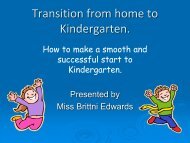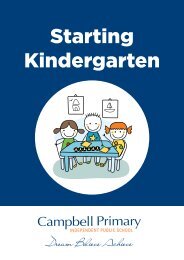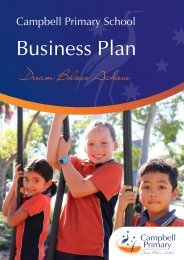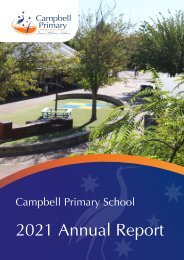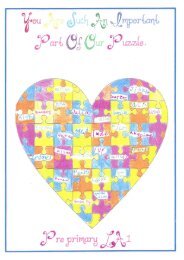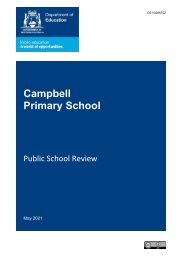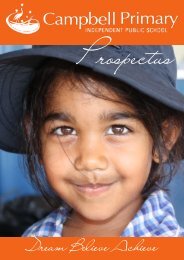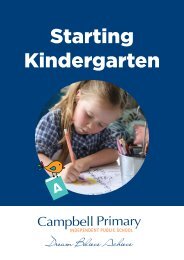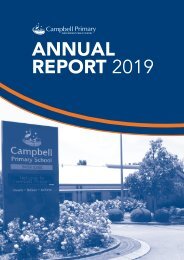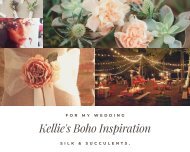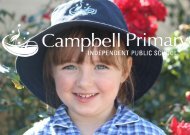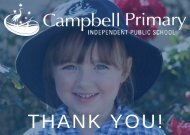Exploring STEM at home
Exploring STEM at home
Exploring STEM at home
Create successful ePaper yourself
Turn your PDF publications into a flip-book with our unique Google optimized e-Paper software.
Kindergarten to Year 2<br />
EXPLORING<br />
<strong>STEM</strong> AT<br />
HOME<br />
Science, technology, engineering<br />
and m<strong>at</strong>hem<strong>at</strong>ics<br />
Activities and ideas for<br />
parents to support their<br />
children’s learning and<br />
development.<br />
© Department of Educ<strong>at</strong>ion, Western Australia 2017
WHAT’S INSIDE<br />
CHILDREN ARE NATURALLY CURIOUS 1<br />
WHAT IS <strong>STEM</strong>? 2<br />
PLAY IS ESSENTIAL FOR LEARNING 3<br />
TOY BOX FUN 4<br />
IN THE KITCHEN 5<br />
QUESTIONING SKILLS 7<br />
LEARNING THROUGH READING 7<br />
ON RAINY DAYS 8<br />
COLLECTING TREASURES 9<br />
THE GREAT OUTDOORS 10<br />
AT NIGHT 12<br />
AT THE BEACH 13<br />
IN THE PARK 13<br />
BUBBLE BLOWING 14<br />
BATH TIME PLAY 15<br />
RETHINK, REDUCE, RECYCLE AND REUSE 16<br />
TITLE: <strong>Exploring</strong> <strong>STEM</strong> <strong>at</strong> <strong>home</strong>:<br />
Science, technology, engineering and<br />
m<strong>at</strong>hem<strong>at</strong>ics.<br />
SCIS NO: 1831078<br />
ISBN: 978-0-7307-4608-9<br />
© Department of Educ<strong>at</strong>ion, Western<br />
Australia 2017<br />
This public<strong>at</strong>ion may be freely copied<br />
in whole or part and in any form<strong>at</strong> in an<br />
educ<strong>at</strong>ion institution for non-commercial<br />
educ<strong>at</strong>ion purposes.<br />
This m<strong>at</strong>erial is available on request in<br />
appropri<strong>at</strong>e altern<strong>at</strong>ive form<strong>at</strong>s.<br />
Department of Educ<strong>at</strong>ion<br />
151 Royal Street<br />
East Perth WA 6004<br />
T: 9264 4111<br />
W: educ<strong>at</strong>ion.wa.edu.au<br />
© Department of Educ<strong>at</strong>ion, Western Australia 2017
CHILDREN ARE<br />
NATURALLY<br />
CURIOUS<br />
Playing, exploring and asking lots of<br />
questions – th<strong>at</strong>’s how children learn<br />
about themselves, about others and<br />
about the world around them.<br />
This booklet has lots of<br />
activities you can do <strong>at</strong><br />
<strong>home</strong> with your children<br />
to support their learning<br />
and development in <strong>STEM</strong><br />
(science, technology,<br />
engineering and<br />
m<strong>at</strong>hem<strong>at</strong>ics).<br />
© Department of Educ<strong>at</strong>ion, Western Australia 2017<br />
1
WHAT IS <strong>STEM</strong>?<br />
<strong>STEM</strong> is an approach to learning and development<br />
th<strong>at</strong> integr<strong>at</strong>es the areas of science, technology,<br />
engineering and m<strong>at</strong>hem<strong>at</strong>ics.<br />
Through <strong>STEM</strong>, children learn to:<br />
• ask questions<br />
• work together<br />
• think cre<strong>at</strong>ively<br />
• solve problems<br />
• explore<br />
• take calcul<strong>at</strong>ed risks<br />
• test solutions<br />
• discover new ways of doing things.<br />
As your child’s first teacher, you can start building<br />
their <strong>STEM</strong> skills from an early age, cre<strong>at</strong>ing a solid<br />
found<strong>at</strong>ion for future learning. By encouraging<br />
your child to play, explore and investig<strong>at</strong>e, you are<br />
helping them become active participants in their<br />
own learning.<br />
With advances in<br />
technology, around<br />
65 per cent of children<br />
starting primary school<br />
are likely to work in jobs<br />
th<strong>at</strong> don’t yet exist.<br />
2 © Department of Educ<strong>at</strong>ion, Western Australia 2017
PLAY IS ESSENTIAL<br />
FOR LEARNING<br />
Play is a fun and important part of<br />
children’s learning and development.<br />
Through play, children:<br />
• are interested in and connected to<br />
wh<strong>at</strong> they are doing<br />
• learn through copying others<br />
• have the freedom to explore their own<br />
interests and answer questions for<br />
themselves<br />
• learn <strong>at</strong> their own pace<br />
• learn to talk and interact with adults<br />
and other children<br />
• develop their imagin<strong>at</strong>ion<br />
• build resilience.<br />
There are many opportunities <strong>at</strong> <strong>home</strong>,<br />
outside and in the community to learn<br />
about <strong>STEM</strong>. And best of all, they’re free.<br />
Mess is good! It’s<br />
an important part of<br />
playing and learning<br />
– so is cleaning up<br />
afterwards.<br />
Wh<strong>at</strong> can I do?<br />
• Develop and respect your child’s curiosity<br />
and cre<strong>at</strong>ivity.<br />
• Let your child discover and learn <strong>at</strong> their<br />
own pace.<br />
• Accept the answers your child provides –<br />
they make perfect sense to them!<br />
• Ask lots of questions. Questions help<br />
your child understand the task.<br />
Give your children the opportunity<br />
to play by themselves and with others<br />
– this builds their confidence and<br />
adaptability skills.<br />
© Department of Educ<strong>at</strong>ion, Western Australia 2017<br />
3
TOY BOX FUN<br />
• With your child, sort objects in the toy box by size,<br />
shape, colour, texture, weight, m<strong>at</strong>erial and use.<br />
• Take two toys and guess which is heavier. Find out<br />
by holding the toys in each hand. Use scales to<br />
compare the weights.<br />
• See how quickly cars, marbles and balls roll down<br />
different surfaces such as baking trays, big books<br />
and planks of wood. See if changing the surface<br />
changes how fast the object goes.<br />
TASK<br />
Make a balance scale by<br />
tying a plastic bag to each<br />
end of a co<strong>at</strong> hanger. Hang<br />
the co<strong>at</strong> hanger on a broom<br />
handle suspended between<br />
two chairs. Place objects in<br />
each bag. See wh<strong>at</strong> happens<br />
when your child adds heavier<br />
and lighter objects.<br />
4 © Department of Educ<strong>at</strong>ion, Western Australia 2017
IN THE KITCHEN<br />
• Show your child th<strong>at</strong> cooking involves<br />
different steps like reading the recipe,<br />
measuring the ingredients and then cooking<br />
in the oven or on the stove.<br />
• Describe to your child wh<strong>at</strong> you are doing<br />
when cooking. Use words such as more,<br />
less, lighter, heavier, melt, cool, hot, cold,<br />
dissolve and set.<br />
• Name and describe ingredients. Get your<br />
child to guess wh<strong>at</strong> will happen when you<br />
mix them together.<br />
• Smell and taste the ingredients (only let your<br />
child taste ingredients you know are safe).<br />
• Talk about how the ingredients change when<br />
you cook them.<br />
Jelly<br />
• Get your child to describe the jelly crystals<br />
before and after w<strong>at</strong>er has been added<br />
(from a solid to a liquid).<br />
• Have your child look in the fridge every half<br />
an hour as the jelly sets and talk about how<br />
it changes.<br />
• Ask wh<strong>at</strong> would happen if some jelly is left<br />
out of the fridge after setting. Try it!<br />
© Department of Educ<strong>at</strong>ion, Western Australia 2017<br />
5
IN THE KITCHEN (CONTINUED)<br />
Play dough<br />
• See how many shapes and p<strong>at</strong>terns you<br />
can make together.<br />
• Add essential oils, glitter and sand to play<br />
dough to change the texture and smell.<br />
Kitchen utensils<br />
• Explore how different kitchen utensils work, like<br />
a can opener and an ice cream scoop.<br />
• Look <strong>at</strong> the reflection on both sides of a spoon.<br />
Ask Why is each side different? and Which side is like<br />
looking in a mirror?<br />
• Get your child to pick up small, big, light and<br />
heavy items with tongs.<br />
TASK<br />
Make a stove with your<br />
child. Talk about the parts<br />
you need, for example an<br />
oven, knobs, switches and<br />
grill. Collect items to cre<strong>at</strong>e<br />
the parts such as boxes,<br />
bottle tops and corrug<strong>at</strong>ed<br />
cardboard. When making<br />
the stove, talk about where<br />
the different parts go and<br />
how they can be <strong>at</strong>tached.<br />
And then paint the stove!<br />
6 © Department of Educ<strong>at</strong>ion, Western Australia 2017
QUESTIONING SKILLS<br />
Questioning encourages children to expand their thoughts r<strong>at</strong>her<br />
than giving yes or no answers.<br />
Ask<br />
Wh<strong>at</strong> does it…<br />
Wh<strong>at</strong> do you think<br />
would happen if…<br />
Why do you think…<br />
How does…<br />
Wh<strong>at</strong> if we…<br />
How can you…<br />
For example<br />
feel like? Close your eyes and<br />
tell me how it feels.<br />
look like? Compare the colour,<br />
p<strong>at</strong>tern, size, shape and texture.<br />
taste like? Have you tasted<br />
something like this before?<br />
smell like? Does it remind you of<br />
something else?<br />
sound like? Where have you<br />
heard this sound before?<br />
we add w<strong>at</strong>er to this?<br />
a playground slide grew bigger?<br />
the shadow has moved?<br />
a robot work?<br />
change the size of the wheels on<br />
different toys?<br />
make blocks balance?<br />
LEARNING THROUGH<br />
READING<br />
With your child, read<br />
The Enormous Turnip<br />
by Irene Y<strong>at</strong>es.<br />
• Talk with your child about the story<br />
using ‘describing’ sentences to give<br />
more inform<strong>at</strong>ion, for example The<br />
turnip is heavy because it is so big.<br />
• Talk about other ways to remove the<br />
turnip, like cutting it into smaller<br />
pieces.<br />
• Talk about different ways to move<br />
objects around the house.<br />
With your child, read<br />
The Very Hungry C<strong>at</strong>erpillar<br />
by Eric Carle.<br />
• With your child, find butterflies in<br />
the garden. Describe the colours<br />
and p<strong>at</strong>terns on their wings.<br />
• Dress up as c<strong>at</strong>erpillars. Move like<br />
a c<strong>at</strong>erpillar. Ask your child to show<br />
you how they would live in a cocoon<br />
– and how they would get out of the<br />
cocoon.<br />
• Talk about how animals and<br />
humans have lifecycles.<br />
© Department of Educ<strong>at</strong>ion, Western Australia 2017 7
ON RAINY DAYS<br />
• Listen to the rain fall on different<br />
surfaces. Ask your child questions<br />
like Wh<strong>at</strong> does it sound like? and<br />
Wh<strong>at</strong> does it smell like?<br />
• W<strong>at</strong>ch wh<strong>at</strong> pets and other<br />
animals do before, during and<br />
after the rain.<br />
• Look <strong>at</strong> the clouds. Talk about<br />
how clouds form different shapes<br />
and colours.<br />
The gre<strong>at</strong> family meltdown<br />
• Give each family member an ice<br />
cube and ask them to find ways<br />
to stop it melting without using<br />
the fridge or freezer. For example,<br />
get them to put it in a sock, wrap<br />
it in foil or bubble wrap, or bury it<br />
in the dirt. Time how long it takes<br />
the ice cubes to melt. Talk about<br />
why some ice cubes melt faster<br />
than others.<br />
TASK<br />
W<strong>at</strong>ch the rain splash<br />
in puddles. Get your<br />
child to make ripples<br />
with their fingers. Look<br />
<strong>at</strong> your reflections.<br />
Splash w<strong>at</strong>er out of the<br />
puddle by jumping in it.<br />
8 © Department of Educ<strong>at</strong>ion, Western Australia 2017
COLLECTING TREASURES<br />
• Collect treasures with your child like shells, small<br />
stones, leaves and fe<strong>at</strong>hers. Display them around your<br />
<strong>home</strong> or keep them in a special place.<br />
• Sort the treasures into groups, for example by colour,<br />
size, texture, shape and the number of edges. Talk<br />
with your child about how each group is similar and<br />
different. Use words like line, circle, square, triangle<br />
and rectangle. Look for repe<strong>at</strong>ed p<strong>at</strong>terns and special<br />
designs.<br />
• Examine each object under<br />
a magnifying glass or take<br />
photos with your phone<br />
and enlarge them on<br />
the screen.<br />
Take lots of photos while<br />
doing activities. Use a<br />
mobile app to change<br />
the way the photos<br />
look. This develops<br />
your child’s digital skills.<br />
© Department of Educ<strong>at</strong>ion, Western Australia 2017<br />
9
THE GREAT OUTDOORS<br />
• Have your child use old kitchen utensils such as<br />
sieves, funnels, dishes and jugs to dig and play with<br />
w<strong>at</strong>er, sand and mud.<br />
• Talk about where w<strong>at</strong>er comes from and where it goes.<br />
Test these ideas by getting your child to paint or spray<br />
w<strong>at</strong>er on a concrete surface and see wh<strong>at</strong> happens.<br />
Extend this activity by discussing how clothes dry after<br />
washing.<br />
• Place torn newspaper into a large jar and soak with<br />
w<strong>at</strong>er. Push some bean seeds half way down the inside<br />
of the jar so they can be seen easily. Put the jar in a<br />
warm, light place and keep the paper moist. W<strong>at</strong>ch<br />
wh<strong>at</strong> happens over a week (the roots grow down from<br />
the seed and the shoots grow up from the seed).<br />
Garden play<br />
• Plant vegetable offcuts and seeds,<br />
flower seeds and seedlings with your<br />
child. W<strong>at</strong>ch how they grow over time.<br />
Take photos to record the changes.<br />
Talk about the changes together.<br />
• Plant them in some different<br />
places to see how they grow<br />
differently (shade or sun, soil<br />
types, pot or garden bed).<br />
Discuss the differences and<br />
wh<strong>at</strong> works best.<br />
TASK<br />
Investig<strong>at</strong>e a small area<br />
of ground with your child<br />
using a magnifying glass.<br />
Ask questions like How<br />
many insects can you see?<br />
Concentr<strong>at</strong>e on one insect<br />
and see wh<strong>at</strong> it is doing.<br />
Follow it to see where it<br />
goes.<br />
10 © Department of Educ<strong>at</strong>ion, Western Australia 2017
© Department of Educ<strong>at</strong>ion, Western Australia 2017<br />
11
AT NIGHT<br />
• Explore outside <strong>at</strong> night with<br />
your child – with and without a<br />
torch. Ask questions like Wh<strong>at</strong><br />
can you see? and Wh<strong>at</strong> can<br />
you hear?<br />
• Make shadows on the wall<br />
with a torch. Talk about how<br />
shadows change when the<br />
torch or objects are moved<br />
closer to or further away from<br />
the wall.<br />
12 © Department of Educ<strong>at</strong>ion, Western Australia 2017
AT THE BEACH<br />
• Get your child to use their senses to explore – like<br />
smelling the air, looking <strong>at</strong> the waves, listening to the<br />
birds, tasting the seaw<strong>at</strong>er and feeling the sand.<br />
• Stand <strong>at</strong> the w<strong>at</strong>er’s edge and let the waves lap up<br />
against your feet. Ask questions like Wh<strong>at</strong> can you feel<br />
under your feet?<br />
TASK<br />
Dig a hole near the w<strong>at</strong>er’s<br />
edge and see how long<br />
it takes to fill with w<strong>at</strong>er.<br />
Talk about where the w<strong>at</strong>er<br />
comes from. Stand in the<br />
hole to see wh<strong>at</strong> happens.<br />
IN THE PARK<br />
• Investig<strong>at</strong>e a tree together. Try and hold hands around<br />
the tree trunk. Ask questions about wh<strong>at</strong> the bark<br />
looks, feels and smells like. See how many colours you<br />
can find. Talk about wh<strong>at</strong> lives in the tree and see if<br />
you can find anything.<br />
• Close your eyes and listen for different sounds. Talk<br />
about wh<strong>at</strong> you can hear, for example the birds and<br />
the wind rustling the leaves. Listen for sounds outside<br />
the park, for example cars and planes.<br />
• Stand still in one place. Talk and ask questions about<br />
the things you can see moving around you like birds<br />
flying overhead, leaves blowing on the ground, dogs<br />
running and people walking.<br />
Playground equipment<br />
• Get swinging! Talk about wh<strong>at</strong> makes the swing work.<br />
Describe how to make the swing go higher.<br />
• Slide down the slide and talk about how and why you<br />
can stop mid-slide.<br />
• Roll an object down the slide. Talk about how to make<br />
it go faster or slower.<br />
© Department of Educ<strong>at</strong>ion, Western Australia 2017<br />
13
BUBBLE BLOWING<br />
• Blow bubbles and get your child to try and c<strong>at</strong>ch them.<br />
Ask questions like Wh<strong>at</strong> makes the bubbles flo<strong>at</strong>? and<br />
Wh<strong>at</strong> makes the bubbles pop? See how long a bubble<br />
can stay in the air.<br />
• Get your child to make bubbles with their hands by<br />
forming a small circle with their thumb and forefinger<br />
and blowing through the circle.<br />
TASK<br />
How to make bubbles<br />
Put 600ml of dishwashing<br />
detergent and 25ml of glycerin<br />
into a one litre container and<br />
fill it with w<strong>at</strong>er. Get your child<br />
to use a pipe cleaner to make<br />
a wand with a circle <strong>at</strong> the top.<br />
Get your child to dip the wand<br />
in the bubble mixture and blow<br />
through the circle.<br />
14 © Department of Educ<strong>at</strong>ion, Western Australia 2017
BATH TIME PLAY<br />
• Put different objects in the b<strong>at</strong>h with your child.<br />
Get your child to see if they flo<strong>at</strong> or sink. Ask them to<br />
guess wh<strong>at</strong> they think might happen before they try.<br />
Ask why some objects flo<strong>at</strong> and others sink. Talk about<br />
ways to make flo<strong>at</strong>ing objects sink, and sinking<br />
objects flo<strong>at</strong>.<br />
• Get your child to fill different objects with w<strong>at</strong>er and<br />
then empty them. Use cleaned shampoo bottles to<br />
squirt w<strong>at</strong>er. Squeeze the bottle when it is empty<br />
and full and talk about how th<strong>at</strong> feels. Squeeze<br />
the bottle under w<strong>at</strong>er and above w<strong>at</strong>er to see wh<strong>at</strong><br />
happens.<br />
Ask questions about wh<strong>at</strong><br />
happens when the b<strong>at</strong>h<br />
plug is removed.<br />
© Department of Educ<strong>at</strong>ion, Western Australia 2017<br />
15
RETHINK, REDUCE, RECYCLE<br />
AND REUSE<br />
Rethink<br />
• R<strong>at</strong>her than driving your child to school, walk there.<br />
If you live far from school, drive part of the way and<br />
walk the rest.<br />
• Encourage your child to think about the way they use<br />
their environment with others. Suggest things like<br />
placing rubbish into bins and tidying up after playing.<br />
Reduce<br />
• Reduce electricity by getting your child to turn off<br />
appliances and lights <strong>at</strong> the wall when they are not<br />
being used. Make signs together as a reminder.<br />
• Get your child to turn off the w<strong>at</strong>er while cleaning<br />
their teeth.<br />
• Show your child the gas, w<strong>at</strong>er and electricity meters<br />
so they understand how utilities are measured.<br />
• Put a bucket in the shower when your child showers<br />
and measure how much w<strong>at</strong>er is collected.<br />
Recycle<br />
• Show your child the ‘recycle’ symbol. Talk about how<br />
important it is to recycle.<br />
• Discuss the sorts of m<strong>at</strong>erials th<strong>at</strong> can and can’t be<br />
recycled.<br />
Reuse<br />
• Reuse paper pl<strong>at</strong>es, boxes, cards, wrapping paper<br />
and ribbon for arts and craft activities. Store buttons,<br />
crayons and pencils in glass or plastic containers.<br />
• Reuse shoeboxes to cre<strong>at</strong>e houses for toys and<br />
treasure boxes.<br />
• Identify ways w<strong>at</strong>er can be collected and reused<br />
around the house, instead of going down the drain.<br />
16 © Department of Educ<strong>at</strong>ion, Western Australia 2017
TASK<br />
Before you throw items<br />
in the rubbish, talk about<br />
wh<strong>at</strong> each item is made of<br />
and ask your child to look<br />
for the recycle symbol.<br />
Sort out the recycling<br />
items together and put<br />
them in the recycle bin.<br />
© Department of Educ<strong>at</strong>ion, Western Australia 2017<br />
17
© Department of Educ<strong>at</strong>ion, Western Australia 2017




